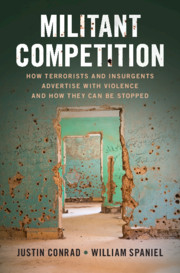
-
Select format
-
- Publisher:
- Cambridge University Press
- Publication date:
- 17 September 2021
- 30 September 2021
- ISBN:
- 9781108992275
- 9781108834186
- 9781108994538
- Dimensions:
- (229 x 152 mm)
- Weight & Pages:
- 0.57kg, 274 Pages
- Dimensions:
- (229 x 152 mm)
- Weight & Pages:
- 0.43kg, 274 Pages
You may already have access via personal or institutional login
Book description
Militant groups often use violence, perversely, to gain attention and resources. In this book, the authors analyze how terrorist and rebel organizations compete with one another to secure funding and supporters. The authors develop a strategic model of competitive violence among militant groups and test the model's implications with statistical analysis and case studies. A series of model extensions allow the authors to incorporate the full range of strategic actors, focusing in particular on government efforts to counter and deter violence. The results indicate that the direct effects of competition are not as clear as they may seem, and interventions to alter competitive incentives may backfire if states are not careful. This is a timely contribution to a growing body of political economy research on militant group fragmentation, rivalry, fratricide and demonstrative violence.
Reviews
‘With impeccable logic and notable inventiveness, the authors explore the dynamics of competition among militant groups. It's an added bonus that they also explain the often paradoxical effects of different state responses. They wisely advocate caution in the adoption of counterterrorism policies.'
Martha Crenshaw - Stanford University
‘This clear and compelling manuscript elaborates the strategic consequences of groups' incentives to produce violence for the purpose of advertising their worth to potential supporters. It centers the importance of competition, and in so doing makes it easy to see how competition drives interesting and sometimes counterintuitive results. Those results offer a strong caution for policy-makers who might otherwise expect one-size-fits-all solutions to the problem of militant violence.'
David Siegel - Duke University
‘While the concept of outbidding has been an important principle in understanding violent group escalation, Conrad and Spaniel move this discussion beyond the simple 'more groups equals more conflict' story. Using rigorous formal theory, connected empirical tests and important case analysis, Conrad and Spaniel show how the second-order effects of militant group competition can lead to unexpected outcomes. While this book will appeal to serious social scientists and scholars of political violence, Conrad and Spaniel address the critical policy implications of the novel theory and data analysis making the book applicable to the public, policymakers, and political scientists. I will assign it in my courses on political violence and terrorism at the undergraduate and graduate level.
Joseph K. Young - American University
Contents
Metrics
Altmetric attention score
Full text views
Full text views help Loading metrics...
Loading metrics...
* Views captured on Cambridge Core between #date#. This data will be updated every 24 hours.
Usage data cannot currently be displayed.
Accessibility standard: Unknown
Why this information is here
This section outlines the accessibility features of this content - including support for screen readers, full keyboard navigation and high-contrast display options. This may not be relevant for you.
Accessibility Information
Accessibility compliance for the PDF of this book is currently unknown and may be updated in the future.


